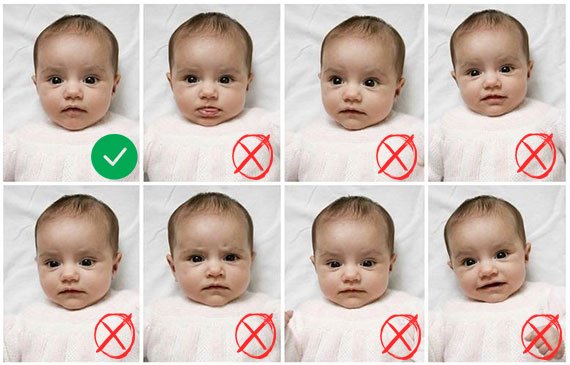Passport photos are a vital requirement when it comes to obtaining a passport for your baby. However, taking a baby passport photo can be challenging, as infants are often uncooperative and can’t sit still for long periods. Fortunately, with a few simple steps and some preparation, you can create a perfect baby passport photo from the comfort of your own home.
Introduce the topic of making a baby passport photo at home and highlight its importance for passport applications. Mention that the article will provide tips, techniques, and a step-by-step guide to achieve a high-quality photo.
1. Why Do You Need a Baby Passport Photo?
Explain the necessity of a baby passport photo for obtaining a passport, emphasizing its role in identification and security measures. Discuss the importance of complying with the official requirements to avoid delays or rejections.
2. Requirements for a Baby Passport Photo
Describe the specific requirements for a baby online passport photo, including size, dimensions, background, lighting, and facial expression. Emphasize the importance of adhering to these guidelines to ensure acceptance by passport authorities.
– Size and Dimensions
Explain the standard size and dimensions required for a baby passport photo, mentioning any variations based on the country or region.
– Background and Lighting
Discuss the appropriate background color, typically plain white or light-colored, and the significance of proper lighting to avoid shadows or reflections.
– Facial Expression and Positioning
Highlight the need for a neutral facial expression, open eyes, and a straight-ahead pose. Mention the importance of keeping the baby’s head straight and avoiding head coverings or toys.
3. Tips for Taking a Baby Passport Photo at Home
Provide a set of helpful tips to prepare for and execute a successful baby passport photo session at home.
– Gather the Required Equipment
List the essential equipment, including a camera or smartphone, a tripod (if available), and any optional props or toys.
– Choose a Suitable Location
Suggest finding a well-lit area in your home with a plain wall or backdrop to set up the photo session.
– Create a Calm and Comfortable Environment
Recommend creating a calm and relaxed atmosphere by ensuring the baby is well-rested, fed, and comfortable.
– Dress the Baby Appropriately
Advise dressing the baby in a simple outfit that contrasts with the background and doesn’t cover the face.
– Ensure Proper Lighting
Provide guidance on achieving adequate lighting, such as utilizing natural light sources or using soft, diffused artificial lighting.
– Capture the Baby’s Attention
Offer suggestions on how to grab the baby’s attention and elicit natural facial expressions, like using toys, making funny sounds, or playing gentle music.
– Use Props or Toys if Necessary
Mention the option of using props or toys strategically to keep the baby engaged and looking in the desired direction.
4. Step-by-Step Guide: How to Make a Perfect Baby Passport Photo from Home
Present a detailed step-by-step guide on capturing a flawless baby passport photo from home, explaining each step in a clear and concise manner.
Step 1: Prepare the Camera or Smartphone
Guide readers on setting up their camera or smartphone for the best quality and resolution. Include tips on adjusting settings like exposure, focus, and image stabilization.
Step 2: Set Up the Background
Describe the process of setting up a plain background and ensuring it is well-illuminated. Offer advice on removing any distractions or objects from the frame.
Step 3: Position the Baby
Explain how to position the baby correctly, keeping their head straight and ensuring the face is fully visible without any obstructions.
Step 4: Ensure Adequate Lighting
Provide detailed instructions on achieving proper lighting, emphasizing the avoidance of harsh shadows or excessive brightness.
Step 5: Capture the Photo
Guide readers on taking the photo, including the importance of sharp focus, proper framing, and capturing the baby’s natural expression.
Step 6: Review and Retake if Necessary
Encourage users to review the captured photo and retake it if it doesn’t meet the requirements or their satisfaction. Offer tips on evaluating the photo’s quality and suggesting improvements.
5. Editing and Adjustments
Discuss the possibility of editing and adjusting the baby passport photo using software or apps to meet the official guidelines.
– Cropping and Resizing
Explain the process of cropping and resizing the photo to meet the required dimensions, ensuring the baby’s face is the focus of the image.
– Adjusting Brightness and Contrast
Provide guidance on adjusting brightness, contrast, and color levels to enhance the photo without making it appear artificial.
– Removing Background or Shadows
Offer tips on removing the background or shadows if necessary, while maintaining a natural and seamless look.
6. Printing and Finalizing the Baby Passport Photo
Guide readers on the final steps of printing and preparing the baby passport photo for submission.
– Choosing the Right Printing Service
Recommend reliable printing services that adhere to official guidelines and offer high-quality prints suitable for passport applications.
– Follow the Official Guidelines
Remind readers to double-check the official guidelines for any specific requirements or restrictions before printing the photo.
– Check for Acceptance
Advise readers to review the printed photo carefully to ensure it meets all the necessary criteria before submitting it with their passport application.
Conclusion
Summarize the key points discussed in the article, emphasizing the importance of a high-quality baby passport photo and providing confidence to readers in their ability to create one at home.
FAQs
A baby passport photo typically lasts the same duration as an adult passport photo, usually ten years for most countries. However, it’s essential to check the specific passport regulations of the country you’re applying to, as the validity period may vary.
Yes, you can use a mobile phone to take a baby passport photo, as long as it meets the required specifications. Ensure that the phone’s camera has a high resolution and produces clear, sharp images. Additionally, make sure to follow all the guidelines for lighting, background, and facial expression to ensure the photo meets the necessary standards.
In most cases, it is necessary to remove the baby’s head covering for the passport photo. Passport authorities require clear visibility of the baby’s face, including the forehead, eyes, and chin. However, religious or medical head coverings may be permitted if they are an integral part of the baby’s daily attire. It’s essential to check the specific guidelines of the passport-issuing authority or consult with them if you have any doubts.
If your baby is constantly moving during the photo session, it can be challenging to capture a clear and acceptable passport photo.
Here are a few tips to help you manage the situation:
● Ensure the baby is well-rested and fed before the photo session to minimize fussiness.
● Have someone assist you in gently holding the baby in place while you take the photo.
● Use toys or other distractions to capture the baby’s attention and keep them engaged.
● Take multiple photos in quick succession to increase the chances of capturing a still moment.
● Be patient and allow breaks if necessary. It may take a few attempts to get the perfect shot.
Yes, different countries may have specific rules and guidelines for baby passport photos. These rules can vary in terms of size, dimensions, background color, facial expression, and more. It’s crucial to refer to the passport-issuing authority or consulate of the country you’re applying to for accurate information. They will provide you with the necessary guidelines to ensure your baby’s passport photo meets their requirements.
Generally, it is best to avoid smiling in a baby’s passport photo. Most passport authorities require a neutral facial expression with the mouth closed, eyes open, and a natural expression. Smiling or any other facial expressions that distort the face may result in the photo being rejected. However, it’s essential to review the specific guidelines of the passport-issuing authority as there may be slight variations.
The red eye is caused by the reflection of the camera flashing off the retina of the eyes. In baby passport photos, red-eye is generally not a significant concern since many guidelines require the use of natural lighting or diffuse artificial lighting. However, if you are using a camera flash, you can minimize the risk of red-eye by having the baby look slightly away from the camera or by using red-eye reduction features available in some cameras or editing software.





















